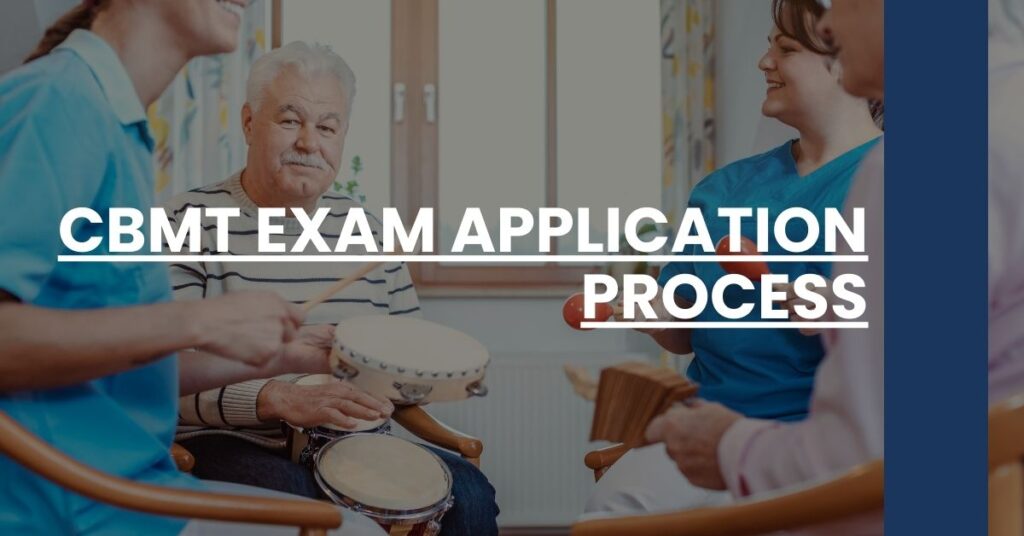Master the CBMT exam application process with ease and set yourself on the path to music therapy certification.
- Eligibility Criteria: Understand the qualifications necessary to apply for the CBMT exam.
- Preparation and Documents: Gather the right documentation and information before beginning your application.
- Exam Scheduling: Learn the steps for scheduling your examination date and location.
Navigate the CBMT exam application process smoothly with this helpful guide.
- Eligibility Criteria for the CBMT Exam
- Preparing to Apply for the CBMT Exam
- The Application Process: Step by Step
- Fees and Payment Information
- Accommodations for Special Needs
- Confirmation and Receipt of Application
- Preparing for the Exam Post-Application
- After the Application: What to Expect
- Dealing with Application Issues
- The Renewal and Restoration Process
- Useful Resources and Support
- Accommodations for Special Needs
- Confirmation and Receipt of Application
- Preparing for the Exam Post-Application
- After the Application: What to Expect
- Dealing with Application Issues
- The Renewal and Restoration Process
- Useful Resources and Support
Eligibility Criteria for the CBMT Exam
Before delving into the CBMT exam application process, you must ensure that you meet the eligibility criteria. These requirements establish a standard that ensures all music therapy professionals have the fundamental knowledge necessary to practice.
Meet Academic and Clinical Training Standards
Academic Training: To become eligible, you must first complete a music therapy degree from an AMTA-approved college or university program. The coursework has to be successfully completed before you move on to the clinical training part.
Clinical Training: Post-academic training, a six-month internship, either as part of or separate from the degree, is required. This hands-on experience is paramount in equipping you with the practical skills to succeed as a music therapist.
Understanding State-Specific Requirements
While national certification through CBMT is essential, it’s also vital to be aware of any additional state licensure requirements. As each state may have different regulations regarding the practice of music therapy, it’s your responsibility to comply with local guidelines besides the national standards set by CBMT.
Preparing to Apply for the CBMT Exam
Embarking on the application journey for the CBMT exam requires diligence and organization. To streamline the process, here’s a checklist to help you ensure that you have everything in order before submitting your application.
Gather Essential Documents
- Official Transcripts: Request that your institution sends your official transcripts directly to CBMT to verify your completion of the necessary educational requirements.
- Proof of Internship Completion: Upon completing your clinical training, ensure that the relevant documentation reflecting this is ready to be submitted.
Understand the CBMT Candidate Handbook
Familiarize yourself with the CBMT Candidate Handbook, which offers invaluable details on the application process, content of the exam, and the code of professional practice. This handbook is your go-to resource throughout the certification journey.
The Application Process: Step by Step
The CBMT exam application process can be simplified into distinct, manageable steps. Following this framework can lessen anxiety and help maintain focus on the ultimate goal.
- Complete Your Internship: Log your clinical hours and confirm the completion of your internship, ensuring eligibility for the examination.
- Submit Your Application: Through the CBMT website, complete the online Examination Application. This step usually involves submitting academic and clinical documentation.
- Schedule Your Exam: Once your application is approved, you will receive information on how to schedule your exam at an approved testing location.
- Application Review: CBMT will review your credentials and, if everything is in order, approve your application.
- Payment: The application process includes a fee, which encompasses both the exam costs and a processing fee. Confirm the current rates and payment methods via the CBMT website.
Remember, while these steps are sequential, some can run concurrently, like preparing for the exam as your application is reviewed.
Fees and Payment Information
The financial aspect of the CBMT exam application process is outlined transparently on the CBMT’s candidate FAQ page.
- Examination Fee: The fee for first-time candidates, including the exam and processing charges, is typically $325. This is subject to change, so always verify the latest information.
- Retake Fee: If you need to retake the exam, familiarize yourself with the reduced fee structure.
Accommodations for Special Needs
Every candidate deserves the opportunity to perform optimally on the CBMT exam. If you require special accommodations due to a disability or other valid reason, you can request adjustments. These provisions align with the standards set by the Americans with Disabilities Act, ensuring fairness and accessibility for all test-takers.
Confirmation and Receipt of Application
Post-application, you should receive a confirmation that CBMT has received your submission. This typically comes in the form of an email or an update on your CBMT online account. It is critical to ensure that your contact information is accurate in order to receive timely updates regarding your application.
Preparing for the Exam Post-Application
While waiting for your CBMT exam date, preparation is critical. Here are some resources to help you prepare effectively:
- Self-Assessment Examination (SAE): Use this tool for a gauge of your readiness.
- Study Guides and Materials: Review recommended texts to deepen your understanding of the exam content areas.
After the Application: What to Expect
After submitting your application, you enter a period of anticipation. Here’s what typically unfolds during that time:
- Scheduling Communication: CBMT will reach out with details on how to schedule your examination date.
- Preparation Alerts: Keep an eye out for any notifications regarding your upcoming exam, such as venue changes or reminders.
Dealing with Application Issues
Should you encounter any hiccups during the CBMT exam application process, these steps can help:
- Contact CBMT: For any questions or concerns, reach out directly to CBMT’s support team.
- Review FAQ: Revisit the candidate FAQs for answers to common issues.
The Renewal and Restoration Process
Certification with CBMT is not a one-time process; maintaining it requires dedication to ongoing education and professional development. Once certification is achieved, explore the CBMT guidelines on recertification to understand the credits and steps required to sustain your credential.
Useful Resources and Support
Here are further resources to support you:
- CBMT Community: Engage with the community for support and advice from peers.
- Practice Exams & Study Groups: Connect with others preparing for the exam to share resources and form study groups.
This thoughtful approach to the CBMT exam application process can help guide you smoothly toward achieving your goal of becoming a board-certified music therapist. With dedication and proper preparation, you’ll be well-equipped to embark on this fulfilling career path.
Accommodations for Special Needs
Recognizing that each candidate is unique, the CBMT exam application process provides a means to request special accommodations in alignment with the Americans with Disabilities Act (ADA). If you have a disability or require specific assistance to take the exam, CBMT ensures that proper arrangements are accessible to support your needs.
How to Request Accommodations
- Identify Your Needs: Carefully consider the type of accommodation that will enable you to effectively take the exam.
- Provide Documentation: Submit professional documentation that clearly outlines your disability and the recommended accommodations.
- Submit Your Request Early: Plan ahead and make your request well in advance of the exam date to allow sufficient time for CBMT to make the necessary arrangements.
Remember that your right to access is respected throughout the CBMT exam application process, and accommodations are there to provide you with an equitable testing environment.
Confirmation and Receipt of Application
Peace of mind comes with knowing that your CBMT exam application has been received and is under review. You can typically expect to receive an email confirmation or an update in your CBMT online account.
Stay Informed
- Check Your Email: Routine checks for any communication from CBMT will keep you in the loop.
- Login Frequently: It’s a good practice to regularly log into your CBMT account for any updates.
Engaging with this part of the process ensures you’re not left wondering about your application status, bolstering your confidence as you prepare for the exam.
Preparing for the Exam Post-Application
After your CBMT exam application is complete, switching gears from applicant to exam candidate involves a significant switch — preparation. Crafting a study plan tailored to your learning style is an essential part of your journey towards board certification.
Personalized Study Strategies
- Utilize Practice Exams: These simulate the test conditions and familiarize you with the exam’s structure.
- Core Material Mastery: Prioritize thorough comprehension of the central concepts in music therapy.
- Mock Examinations: Training under timed conditions can build your resilience and pacing for the actual exam.
Resources
The Self-Assessment Examination (SAE) is an excellent gauge of your current knowledge and a window into the areas that may require further study. Incorporating feedback from mock exams into your study routine is crucial for success.
After the Application: What to Expect
Once your CBMT exam application is processed, moving towards the exam itself involves a clear set of expectations. From receiving scheduling details to preparation requirements, you’ll be apprised every step of the way.
Crucial Moments Post-Application
- Ensure contact information is current for receiving scheduling details.
- Stay informed about exam center rules and preparation guidelines.
This phase’s organized approach means you will have a clear understanding of what lies ahead, allowing you to focus on your preparation with reduced stress.
Dealing with Application Issues
If unexpected challenges arise during your CBMT exam application process, remember — solutions are at hand, and assistance is readily available.
Effective Problem-Solving Steps
- Direct Communication: Reaching out to CBMT’s support staff can clarify and resolve most issues quickly.
- Resourceful Use of FAQs: The candidate FAQs are a treasure trove of solutions to common application hurdles.
Proactive steps can remedy potential roadblocks, ensuring that your path to certification remains clear and direct.
The Renewal and Restoration Process
Achieving your initial certification is only the beginning – maintaining your MT-BC credential requires ongoing attention to professional growth. The CBMT outlines a clear process to ensure you remain at the forefront of the ever-evolving field of music therapy.
Continuing Certification
- Recertification Credits: Engage in activities that not only develop your professional skillset but also count towards your recertification.
- Stay Active Professionally: Whether through practice or further education, keep your skills sharp and a credential valid.
Useful Resources and Support
As you navigate the CBMT exam application process, several key resources and support systems can ensure you’re well prepared. Leverage these to boost your confidence and exam readiness.
Enhance Your Exam Prep
- Review Study Guides: These resources distill key information into structured formats, aiding in memorization and comprehension.
- Join Study Groups: Collaboration with peers can provide moral support and deeper learning through discussion.
Integrating these resources into your study regimen enriches your preparation, offering multiple pathways to absorb and retain information imperative to passing the CBMT exam.
By staying diligent and making the most of the resources and supports available, you can walk into your CBMT exam with confidence, fully prepared to take the next step in your music therapy career.
CBMT exam application process: Navigate every step to certification with our comprehensive guide. Achieve professional music therapy credentials.

